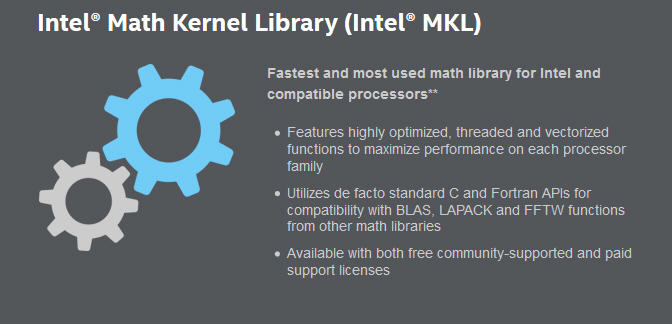Welcome to LZN's Blog!
Wind extinguishes a candle but energizes fire.-
GFDL Spectral Idealized port on SAVIO
copy and paste to create
mkmf.template.savio.without_mpi in ./bin/
change:
FC CC MPI and NetCDF pathes.
in ./full_dynamics, change:
compile_full_dynamics_on_savio.csh to fit savio (usually, just change platform name is okay).
when compile, error:
ifort: error #10031 error: could not write to argument file
google it:
https://software.intel.com/en-us/forums/intel-math-kernel-library/topic/281453
The MKL libraries are in different directories than the compiler runtime and other libraries. By default, the compiler will not search for libraries in the MKL lib directory. Use the -mkl compiler option for simple jobs, and use the MKL Link Line Advisor for more intricate jobs.
When I tried -mkl it doesn’t work and appeared another error.
Fortunately, when I tried to module load ant TAB it, a module called
mkl/2013_sp1.4.211
just came into my eye.
of course, use it! The problem really solved.
So what is mkl?
-
Externalities and the Coase Theorem
Coursera
The price changes, the quantity of the demand changes, not the demand change!
compliment of xxx / complementary good互补品
Change in demand: demand curve change!
inferior good 低档商品
ceteris paribus其他条件不变
- Externalities
- Positive
- Example: Education
- Negative
- Example: Pollution
- Measure Example: Pigouivain tax-->Pareto Optimality
- Positive
- Coase theorem
-
科斯定理的两个前提条件:明确产权和交易成本 钢铁厂生产钢,自己付出的代价是铁矿石、煤炭、劳动等,但这些只是“私人成本”;在生产过程中排放的污水、废气、废渣,则是社会付出的代价。如果仅计算私人成本,生产钢铁也许是合算的,但如果从社会的角度看,可能就不合算了。于是,经济学家提出要通过征税解决这个问题,即政府出面干预,赋税使得成本高了,生产量自然会小些。但是,恰当地规定税率和有效地征税,也要花费许多成本。于是,科斯提出:政府只要明确产权就可以了。如果把产权“判给”河边居民,钢铁厂不给居民们赔偿费就别想在此设厂开工;若付出了赔偿费,成本高了,产量就会减少。如果把产权界定到钢铁厂,如果居民认为付给钢铁厂一些“赎金”可以使其减少污染,由此换来健康上的好处大于那些赎金的价值,他们就会用“收买”的办法“利诱”厂方减少生产从而减少污染。当厂家多生产钢铁的赢利与少生产钢铁但接受“赎买”的收益相等时,它就会减少生产。从理论上说,无论是厂方赔偿,还是居民赎买,最后达成交易时的钢产量和污染排放量会是相同的。但是,产权归属不同,在收入分配上当然是不同的:谁得到了产权,谁可以从中获益,而另一方则必须支付费用来“收买”对方。总之,无论财富分配如何不同,公平与否,只要划分得清楚,资源的利用和配置是相同的——都会生产那么多钢铁、排放那么多污染,而用不着政府从中“插一杠子”。那么政府做什么呢?明确产权,并且有效地保护产权。科斯定理表明,市场的真谛不是价格,而是产权。只要有了产权,人们自然会“议出”合理的价格来。但是,明确产权只是通过市场交易实现资源最优配置的一个必要条件,却不是充分条件。另一个必要条件就是“不存在交易成本”。交易成本,简单地说是为达成一项交易、做成一笔买卖所要付出的时间、精力和产品之外的金钱,如市场调查、情报搜集、质量检验、条件谈判、讨价还价、起草合同、聘请律师、请客吃饭,直到最后执行合同、完成一笔交易,都是费时费力的。就河水污染这个问题而论,居民有权索偿,但可能会漫天要价,把污染造成的“肠炎”说成“胃癌”;在钢铁厂有权索要“赎买金”的情况下,它可能把减少生产的损失一元说成十元。无论哪种情况,对方都要调查研究一番。如果只是一家工厂和一户居民,事情还好办。当事人的数目一大,麻烦就更多,因为有了“合理分担”的问题。如果是多个厂家,谁排了污水、排了多少,他们如何分摊赔偿金或如何分享“赎买金”就要先扯皮一番;如果是多户居民,谁受害重谁受害轻,怎么分担费用或分享赔偿,也可打得不可开交。正是这些交易成本,可能使得前面所说的那种由私人交易达到的资源配置无法实现——或是大家一看有这么多麻烦,望而却步。所以说,科斯定理的“逆反”形式是:如果存在交易成本,即使产权明确,私人间的交易也不能实现资源的最优配置。
-
- Externalities
-
Fortran direct recl problem
recl = n or recl = 4*n?
this is a problem from a non-standard extensions of fortran: VMS fortran.
http://www-mipl.jpl.nasa.gov/portguide/subsection3.9.7.html
https://docs.oracle.com/cd/E19957-01/805-4939/6j4m0vnct/index.html#c40004b91a0e
typically, using ifort, dont do that.
- R星创始人、《侠盗猎车手》与《荒野大镖客》创作者丹·豪瑟2025年11月播客实录 | 中英文完整版精译 Part3
- R星创始人、《侠盗猎车手》与《荒野大镖客》创作者丹·豪瑟2025年11月播客实录 | 中英文完整版精译 Part2
- R星创始人、《侠盗猎车手》与《荒野大镖客》创作者丹·豪瑟2025年11月播客实录 | 中英文完整版精译 Part1
- Existence Series (Part 1) | Eternal Recurrence: If your life ended right at this moment, would you choose to replay it?
- 存在篇(一) | 永恒轮回:如果,你的生命,终止于此时此刻,你会选择重播它么?
- Earth: My Past 45 and a Half Years Have Been Relatively Peaceful, Until I Raised Humans for 8 Hours...
- 地球:我过去45年半过得还算平静,直到养了8小时的人类……
- Telegram创始人帕维尔·杜罗夫2025年10月播客实录 | 中英文完整版精译 Part4
- 高压教育、游戏开发、极致优化:Telegram创始人帕维尔·杜罗夫2025年10月播客实录 | 中英文完整版精译 Part3
- Telegram创始人帕维尔·杜罗夫2025年10月播客实录 | 中英文完整版精译 Part2
